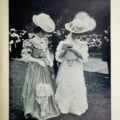Erik Satie In 1920s fashion – Sports et Divertissements
June 26, 2016Sports et Divertissements fell a little flat on its eventual 1923 release. Thereafter gaining reputation only gradually and greatly boosted with the resurgence in interest of Satie’s work.This was occasioned by John Cage’s Erik Satie festival at Black Mountain College in the 1960s. You can find a really good recording of the music played by Michael Seregow here. It comes complete with black and white versions of the illustrations and Satie’s poetry-like comments.
The reception of Sports et Divertissements
Jazz and wild dancing weren’t invented in the 1920s but were right there already. A great example of this is Sports et Divertissements, by Charles Martin and Erik Satie. Parisian connoisseurs in 1914 had a taste for limited edition deluxe collectors albums of handmade pochoir prints of 1920s womens fashion.These were combined with witty words and sometimes printed music which were known as livre d’artiste, artist’s books.
These incredibly expensive beautiful coffee table books were created by top artists and illustrators of the day.Artists and illustrators whose designs would be hand stencilled and augmented by a sentence or two from a fashionable poet or some sheet music by a well-known composer designed to be played whilst browsing the images.
Nowadays we have CDs with “limited edition” prints folded and tucked into the sleeve – imagine that but on a high quality, heavy paper, and a live pianist tinkling the tune. I expect you’d need a martini in hand too, with a butler to pass it to you and to be wearing some delectably gauzy latest fashion by Lucile or Paul Poiret. Perhaps you’ve even organised a soiree to enjoy this exclusive work with your friends. Think a scene from Great Gatsby, only the women are wearing fashions from 1914, not 1923 womens fashion.
Erik Satie and Charles Martin
“War, war, war; this war talk is spoiling all the fun at every party this spring. I get so bored I could scream.”OK, so the line is from Gone With the Wind and Scarlett O’Hara was talking about the American Civil War, but it sums up exactly the feeling of some people towards what turned into the First World War.High society across Britain and Europe were enjoying a balmy summer in 1914, with seemingly endless tennis matches blending into endless parties.But the breakout of war made it somehow a little de trop to lounge around listening to decadent little tunes. This is exactly what happened with Sports et Divertissements. It was commissioned in 1914 by the publisher Lucien Vogel.
Lucien Vogel specialised in the livre d’artiste, alongside the fashion bible of the time, magazine Gazette du Bon Ton. In response to twenty simple titles like “The Swing”, “Hunting”, “Fishing”, “Golf” and “The Carnival”, all suggesting pleasant diversions for upper class people. Illustrator Charles Martin provided a series of twenty elegant copper plate etchings. These were showing beautiful people at play in the latest 1920s women fashions.In addition, composer Erik Satie added the sheet music for twenty-one tiny musical sketches to go alongside them (one for each title plus an introduction).
Each one is only about thirty seconds long, and the whole suite lasts only twelve minutes or so. Satie also provided humorous and rather oblique texts to go with each situation, some rather haiku-like, such as “It’s my heart that is swinging like this. It isn’t dizzy. What little feet it has. Will it be willing to return to my breast?”
Sports et Divertissements
The Sports et Divertissements portfolio was a lovely piece of froth that was suddenly unsuitable for the decidedly un-frothy times it found itself. It was shelved until 1923, a more suitable time for such decadence. This is just one example of why the Roaring Twenties were just waiting to happen, hibernating through the war years.
Roaring Twenties waiting to happen
When it was finally published, Charles Martin felt that his original illustrations were out of date and promptly set to in designing a whole set of new ones. Some sources feel that his mode of illustration seemed old-fashioned by then.The new drawings were slightly more abstract, influenced by Cubism. Others think it was simply in order to update the fashions to something more reflecting 1923 womens fashion that he made the change. Perhaps the publisher demanded something new for both of these reasons. However, the original scores and words by Satie remained exactly the same, as they hadn’t dated in the intervening years.
Erik Satie and Stravinsky
There is also some debate about how much of a genius Satie was in working closely together with Martin to create music and pictures that exactly reflected the pursuits in the titles. In reality, the pair didn’t choose to symbiotically work together as they felt that they were a perfect partnership. In fact they may not even have met.
The gig had first been offered to the stratospherically fashionable Igor Stravinsky, who turned it down because the fee was too low. It then went to Erik Satie, who, legend has it, at first turned it down because the fee was too high. Being a modest, unworldly sort, he finally accepted it at a fee that was much lower that the one Stravinsky had turned town – but still the highest fee that Erik Satie received in his whole life for a commission. (The probable fact is that Satie’s assistant tried to negotiate a higher fee for the work, and the terrified Satie, fearing he’d lose the job altogether as a relative unknown, intervened, saying he was happy with less, thank you very much).
Since Charles Martin had already worked together with the publisher as an illustrator on several magazines and other illustration jobs. It was likely that he and the publisher came up with the titles and different situations first as an outline, and then produced his 1914 etchings before the drawings were handed over whichever composer was chosen, in this case Satie, to base their scores and words on. Satie was not even informed that the illustrations would be changing entirely for the 1923 portfolio with updated 20s fashion.
Charles Martin’s 1914 etchings
Charles Martin’s original 1914 etchings are as rare as hen’s teeth. Only ten sets of the twenty designs were ever printed, and they were bound into the first ten copies of the 1923 edition, along with the updated versions featuring womens 1920s fashion and Satie’s music. These copies were never meant for sale but as a record of the endeavour, and all ten were intended for the Librairie Maynial, although they have now made their way into private hands.
The next 215 issues, also printed in 1923, featured all twenty of the updated hand coloured pochoir prints along with the scores. The final 675 of the 1923 folios featured the entire score, but only one full colour example of Charles Martin’s new illustrations showing beautiful 1920s female fashion. Altogether only 900 copies of Sports et Divertissements were printed by Lucien Vogel. It has been re-printed five times since much less luxuriously by various publishers and in much greater quantities, with a focus on the music with the 1920s women fashion drawings as an afterthought.
The 1914 etchings
The 1914 etchings are simple black and white line drawings, although the intention may have been to colour them, perhaps with aqua tint, before the project was temporarily abandoned. The 1923 versions are sumptuously coloured pochoir prints.
Charles Martin the illustrator
Charles Martin (1884–1934) was an in-demand, fashionable illustrator, educated in Montpellier where he was born and at the Académie Julian and the Beaux-Arts in Paris. He contributed to the Gazette du Bon Ton and the Journal des Dames et des Modes, Modes et Manieres d’Aujourd’hui, and Vogue as well as designing theatre, ballet and advertising posters.
His fashion illustration work picks up the fashionable Art Nouveaux line, and has echoes of Aubrey Beardsley and Erte, while showing a strong Japanese wood block printing influence. An even stronger Japanese influence on his work is shunga, erotic wood block prints that were fairly prolifically produced in Japan in the nineteenth century. Martin followed their example by producing some witty erotic womens 1920s fashion prints of his own, an interest that is shown by his delight in managing to show nearly every female nipple possible in his 1920s ladies fashion suite for Sports et Divertissements.
Erik Satie the composer
Erik Satie (1866 – 1925) came to be a well-known jazz musician. Professionally, he is known for his innovative piano music, probably most famously the very catchy Gymnopédies and Gnossiennes. He is also known for inventing background music, which he called “furniture music”, as he wanted it to be as unnoticeable as the furniture.
He was also an interesting essay writer and a thinker with an unusual take on events. Personally, he is known for his extreme eccentricity. He was known as “The Velvet Man” after buying seven identical grey corduroy suits which he then wore unvaryingly for the next twenty years. He once threw a girlfriend out of a window – but being an acrobat, she bounced right back.
He also established his own religious sect in Montmartre, claimed to only eat white foods, and worked with the artistic big hitters of the time.These included Picasso, Cocteau, and Diaghilev, whilst being friends with other radical artists such as Man Ray, Brancusi and Duchamp. But no-one was ever allowed to visit him at his home. Far from being in the thick of it, in his late twenties Satie moved to a bed sit in suburban Montmartre, where nobody but stray dogs were allowed in. He lived there alone until his death in 1925.











